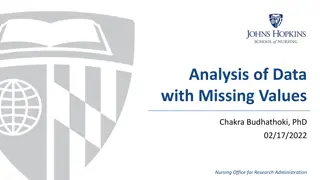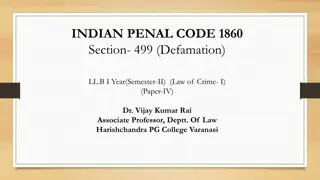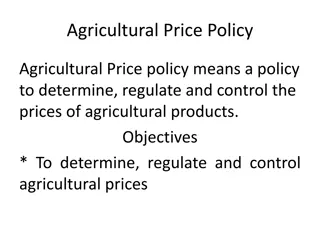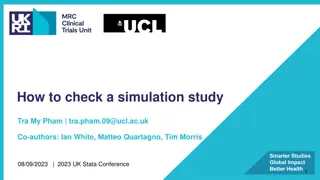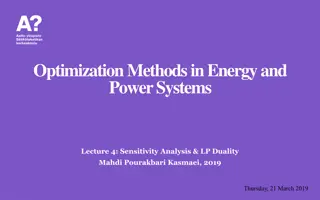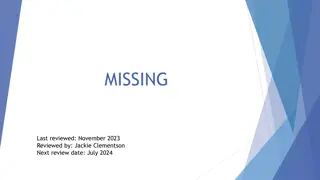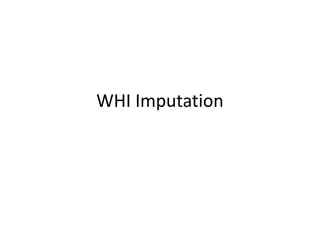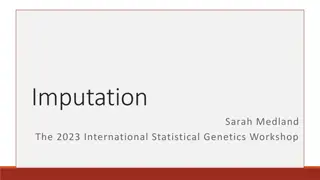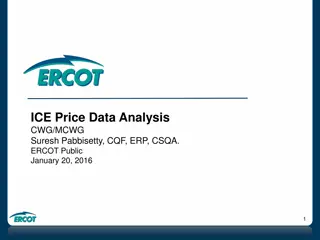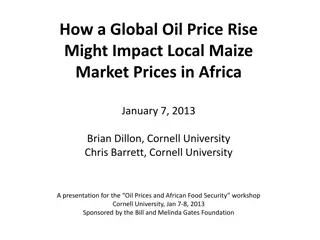Advanced Imputation Methods for Missing Prices in PPI Survey
Explore the innovative techniques for handling missing prices in the Producer Price Index (PPI) survey conducted by the U.S. Bureau of Labor Statistics. The article delves into different imputation methods such as Cell Mean Imputation, Random Forest, Amelia, MICE Predictive Mean Matching, MI Predictive Mean Matching, and MICE Classification and Regression Trees. Understand the concepts of missing data mechanisms, including Missing at Random (MAR), Missing Not at Random (MNAR), and Missing Completely at Random (MCAR). Discover how to create simulated data sets to test and enhance the imputation processes.
Download Presentation

Please find below an Image/Link to download the presentation.
The content on the website is provided AS IS for your information and personal use only. It may not be sold, licensed, or shared on other websites without obtaining consent from the author.If you encounter any issues during the download, it is possible that the publisher has removed the file from their server.
You are allowed to download the files provided on this website for personal or commercial use, subject to the condition that they are used lawfully. All files are the property of their respective owners.
The content on the website is provided AS IS for your information and personal use only. It may not be sold, licensed, or shared on other websites without obtaining consent from the author.
E N D
Presentation Transcript
Imputation Methods for Missing Prices in the PPI Survey Yoel Izsak Monica Moleres Bureau of Labor Statistics November 2, 2021 1 U.S. BUREAU OF LABOR STATISTICS bls.gov
PPI at BLS The Producer Price Index (PPI) program measures the average change over time in the selling prices received by domestic producers for their output. The prices included in the PPI are from the first commercial transaction for most products and some services. Data collection consists of a voluntary survey for probability selected production companies in over 500 different industries Survey Units report monthly, data is considered missing if we do not receive an item s price for a month 2 U.S. BUREAU OF LABOR STATISTICS bls.gov
Industry and Cell Structure Current Method: Cell Mean Imputation Cell Indexes: the index for lowest level grouping of items in each industry Each Cell Index is aggregated up the tree structure (seen below) to compute the industry index Tree Structure ok 3 U.S. BUREAU OF LABOR STATISTICS bls.gov
Cell Mean Imputation (48 75818129.1 + 38 181910909.1) (48 75818129.1 + 36 181910909.1)= 1.035 ???? ??? ????? ? ???? ?? ???????? ??????: ????? ???? ????? ? ???? ?? ??????? ?????: 50.4346 1.035 = 52.2351 4 U.S. BUREAU OF LABOR STATISTICS bls.gov
Missing Data Mechanisms Missing at Random (MAR): Missing Price related to Observed Variable Missing Not at Random (MNAR): Missing Price related to Price Missing Completely at Random (MCAR): Missing Price related to No Variable 5 U.S. BUREAU OF LABOR STATISTICS bls.gov
Imputation Methods Random Forest (RF) -> mice(data, m = 20, method = "rf") Amelia (AMELIA) -> amelia(data, m = 5, p2s = 1, idvars = c("ITEM"), noms = c("REGION", "MAJORPRODUCER"), bounds = bounds, empri = .01*nrow(data)) MICE Predictive Mean Matching (MICE) -> mice(data, m = 5, method = "pmm") MI Predictive Mean Matching (MI) -> mi(data, n.iter = 20, n.chains = 10, max.minutes = 20) MICE Classification and Regression Trees (CART) -> mice(data, m = 5, method = "cart") 6 U.S. BUREAU OF LABOR STATISTICS bls.gov
Simulated Data Sets 1. Take all of the items with reported prices to use as the control dataset approximately 60% of the data Simulate prices with 40% missing data, simulated missing using variables found to influence if a price is missing Run imputation methods on the simulated datasets, then compare to the control dataset later 2. 3. Metric of precision: Root Mean Square Error of the industry index 2 ? ?=1 ??????? ???????? ???? = ? 7 U.S. BUREAU OF LABOR STATISTICS bls.gov
Variable Selection Process Step 1. Exclude variables with no possible way of predicting price, also duplicate variables Example: Street Address, Company Name have no relation to Price Change 8 U.S. BUREAU OF LABOR STATISTICS bls.gov
Variable Selection Process Step 2. Certain variables are not feasible to use in specific software packages, due to run time Example: Over 500 current product codes, some software packages crashed 9 U.S. BUREAU OF LABOR STATISTICS bls.gov
Variable Selection Process Step 3: Which combination of variables produces the lowest RMSE compared to the control data Compare index estimates from imputed datasets to those produced by the control dataset 10 U.S. BUREAU OF LABOR STATISTICS bls.gov
Variable Comparison Variables 11 U.S. BUREAU OF LABOR STATISTICS bls.gov
Improve upon Cell Mean Overall, there was not enough evidence to suggest that switching imputation methods would be beneficial for our data Problems: 1. No minimum threshold for calculating cell mean. With only 1 reported price in a cell, all other items will exactly follow that single price 2. If we have no good prices for a month, aggregate (higher level) index cells are used, and this works poorly ok 13 U.S. BUREAUOF LABOR STATISTICS bls.gov
Possible Solutions Problems: 1. No minimum threshold for calculating cell mean. With only 1 reported price in a cell, all other items will exactly follow that single price Institute a minimum threshold such as number of reported prices or percentage of reported weight 2. If we have no good prices for a month, aggregate (higher level) index cells are used, and this works poorly Instead, use Random Forest to impute prices for that cell 14 U.S. BUREAUOF LABOR STATISTICS bls.gov
Proposed Initial Solution CMRF: Step 1: Add in 2 reported price minimum and increase the percent reported weight threshold to 25% reported weight. Step 2: If conditions fail, use Random Forest 15 U.S. BUREAUOF LABOR STATISTICS bls.gov
Further Exploration Do we need both the reported price number minimum and reported percentage weight minimum? 17 U.S. BUREAUOF LABOR STATISTICS bls.gov
Change in Criteria Decided to drop reported price minimum down to one, two good prices only affect an additional 6% of cells 20 U.S. BUREAUOF LABOR STATISTICS bls.gov
Current Recommendation Cell Mean Random Forest: Step 1: Instate a minimum 20-25% reported item weight threshold Step 2: If threshold is not met, use Random Forest to impute prices So far we have run these processes on industry indexes, commodity index results in the works 21 U.S. BUREAUOF LABOR STATISTICS bls.gov
References and Further Reading 1. Missing Data Mechanisms https://www.theanalysisfactor.com/missing-data-mechanism/ 2. PPI Concepts and Methods https://www.bls.gov/opub/hom/pdf/ppi-20111028.pdf 3. Missing Data, Imputation, and Regression Trees http://pages.stat.wisc.edu/~loh/treeprogs/guide/LZZZ20.pdf 4. Imputation of Missing Data https://stefvanbuuren.name/fimd/sec-problem.html 22 U.S. BUREAUOF LABOR STATISTICS bls.gov






